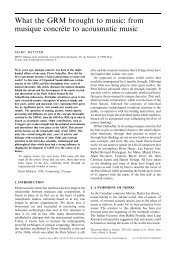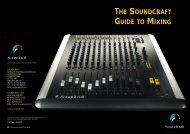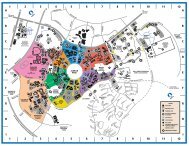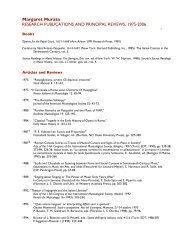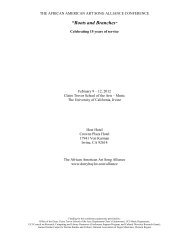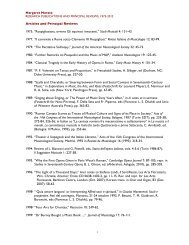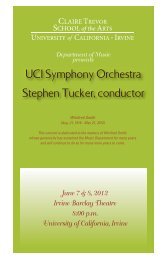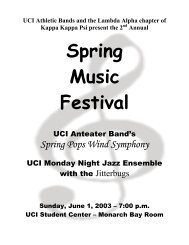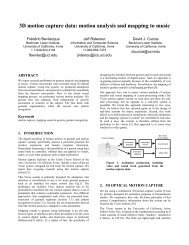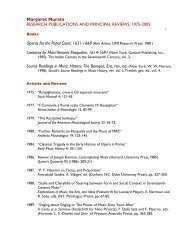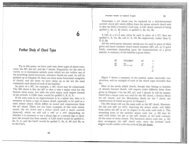amy bauer The Other of the Exotic: Balinese Music as Grammatical ...
amy bauer The Other of the Exotic: Balinese Music as Grammatical ...
amy bauer The Other of the Exotic: Balinese Music as Grammatical ...
You also want an ePaper? Increase the reach of your titles
YUMPU automatically turns print PDFs into web optimized ePapers that Google loves.
<strong>The</strong> <strong>O<strong>the</strong>r</strong> <strong>of</strong> <strong>the</strong> <strong>Exotic</strong> 345<br />
moments. <strong>The</strong> result is a constant shifting <strong>of</strong> <strong>the</strong>ir rhythmic roles. <strong>The</strong> <strong>Balinese</strong><br />
see <strong>the</strong> different levels <strong>of</strong> melodic structure <strong>as</strong> <strong>the</strong> trunk and branches <strong>of</strong> a<br />
great tree; kotekan are <strong>the</strong> ‘flowers’ <strong>of</strong> <strong>the</strong> composition and <strong>of</strong>ten represent<br />
<strong>as</strong>pects <strong>of</strong> <strong>the</strong> pokok in microcosm, in <strong>the</strong> sense that small segments <strong>of</strong> <strong>the</strong><br />
melody may be repeated at f<strong>as</strong>ter speeds to ornament <strong>the</strong> underlying cantus. 17<br />
<strong>The</strong>re are several types <strong>of</strong> kotekan patterns; in some <strong>the</strong> polos and sangsih parts<br />
never intersect, but in o<strong>the</strong>rs <strong>the</strong>y share notes with one ano<strong>the</strong>r or with <strong>the</strong><br />
pokok. Syncopation and simultaneous attacks exchanged between ornamental<br />
and pokok notes establish a complex hierarchy <strong>of</strong> dynamic accents. Seven<br />
strictly hierarchical rhythmic levels can be deduced from Ex. 2, but <strong>the</strong>se represent<br />
only <strong>the</strong> most obvious structural events. 18 <strong>The</strong>y might be expanded to<br />
include <strong>the</strong> acoustic effect <strong>of</strong> ‘beats’ between two instruments which always<br />
play <strong>the</strong> same kotekan part but with slightly different tunings, or with shifts in<br />
texture and articulation which accompany repetitions <strong>of</strong> <strong>the</strong> b<strong>as</strong>ic cycle. 19<br />
In this music <strong>the</strong>re is no sense <strong>of</strong> tension between strong and weak beats, no<br />
arsis and <strong>the</strong>sis <strong>as</strong> typically conceived within <strong>the</strong> Western tradition. Ra<strong>the</strong>r, <strong>the</strong><br />
sangsih and polos <strong>of</strong> kotekan are complementary <strong>as</strong>pects <strong>of</strong> <strong>the</strong> single rhythm<br />
which <strong>the</strong>y intersect to produce, and each player must perceive both <strong>as</strong> part <strong>of</strong><br />
his or her performance. As Wayne Vitale notes, <strong>the</strong> extreme speed and melodic<br />
variety <strong>of</strong> interlocking lines, along with <strong>the</strong> sharp metallic attack <strong>of</strong> <strong>the</strong><br />
instruments,<br />
seems to many upon first hearing to be <strong>the</strong> sound <strong>of</strong> a machine, some frenetic<br />
music box set to twice its normal speed ... . One might imagine, <strong>as</strong> an analogy, <strong>the</strong><br />
text on this page being read by two narrators, one <strong>of</strong> whom pronounces only <strong>the</strong><br />
letters a through m, and <strong>the</strong> o<strong>the</strong>r n through z, yet fitting those sounds toge<strong>the</strong>r<br />
so perfectly that we hear <strong>the</strong>m <strong>as</strong> one speaker. (Vitale 1990, p. 7)<br />
A less abstract description w<strong>as</strong> <strong>of</strong>fered by Hardja Susilo: ‘In <strong>Balinese</strong> gamelan<br />
half <strong>the</strong> group plays <strong>as</strong> f<strong>as</strong>t <strong>as</strong> <strong>the</strong>y can, and <strong>the</strong> o<strong>the</strong>r half plays <strong>as</strong> f<strong>as</strong>t <strong>as</strong> <strong>the</strong>y<br />
can, in between’. 20 Patterns within <strong>the</strong> kotekan and its underlying parts exhibit<br />
a mix <strong>of</strong> symmetry and irregularity, part <strong>of</strong> <strong>the</strong> dialectic between st<strong>as</strong>is and<br />
mobility or flow (ngubeng and majalan respectively) characteristic <strong>of</strong> <strong>Balinese</strong><br />
compositions. 21<br />
Kebyar Melodic Structure<br />
<strong>The</strong> nine-beat opening pokok melody <strong>of</strong> Ex. 3 (bars 1–3) creates a palindrome,<br />
E–G–D–E–C ♯ –E–D–G–E. (<strong>Balinese</strong> melodies always end on a downbeat.) <strong>The</strong><br />
central descent to C ♯ is part <strong>of</strong> <strong>the</strong> colotomic structure, <strong>the</strong> interval <strong>of</strong> a third<br />
which anchors this opening ‘phr<strong>as</strong>e’. Heterophony obscures <strong>the</strong> intervallic and<br />
rhythmic compression <strong>of</strong> core melodic segments in <strong>the</strong> kotekan embellishment.<br />
Yet a contour graph <strong>of</strong> <strong>the</strong> first four kotekan segments (kotekan are typically<br />
conceived <strong>as</strong> end-accented, two-beat patterns) reveals a canon between polos and<br />
sangsih from beat 1 to beat 4, and inversional symmetry between parts from beat<br />
5 to beat 9, <strong>as</strong> shown in Ex. 3. 22<br />
<strong>Music</strong> Analysis, 27/ii-iii (2008)<br />
© 2009 <strong>The</strong> Author.<br />
Journal compilation © 2009 Blackwell Publishing Ltd.



